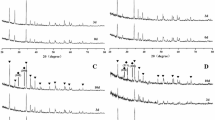Abstract
The bioactivity of a range of glass-ceramic apatite–wollastonite (A–W) – polyethylene composites (AWPEXs) with glass-ceramic A–W volume percentages ranging from 10 to 50, has been investigated in an acellular simulated body fluid (SBF) with ion concentrations similar to those of human blood plasma. The formation of a biologically active apatite layer on the composite surface after immersion in SBF was demonstrated by thin-film X-ray diffraction (TF-XRD) and field-emission scanning electron microscopy (FE-SEM). An apatite layer was formed on all the composites, with the rate of formation increasing with an increase in glass-ceramic A–W percentage. For composites with glass-ceramic A–W filler contents ≥30 vol %, the apatite layer was formed within 12 h of immersion, which is a comparable time for apatite formation on monolithic glass-ceramic A–W. Inductively coupled plasma atomic emission spectroscopy (ICP-AES) demonstrated that the apatite formation on AWPEX samples with 50 vol % filler content occurred in a manner similar to that seen on pure glass-ceramic A–W, in that the calcium, silicon, and magnesium ion concentrations increased and, conversely, a decrease was observed in the phosphate ion concentration. These results indicate that a suitable in vitro response was achieved on a composite incorporating particulate glass-ceramic A–W with a particularly favorable response being observed on the AWPEX sample with 50 vol % filler content.
Similar content being viewed by others
References
T. Kokubo, M. Shigematsu, Y. Nagashima, M. Tashiro, T. Nakamura, T. Yamamuro and S. Higashi, Bull. Inst. Chem. Res., Kyoto Univ. 60 (1982) 260.
M. Jarcho, C. H. Bolen, M. B. Thomas, J. Bobick, J. F. Kay and R. H. Doremus, J. Mater. Sci. 11 (1976) 2027.
D. M. Liu and H. M. Chou, J. Mater. Sci.: Mater. Med. 5 (1994) 7.
T. Kokubo, Biomater. 12 (1991) 155.
A. Ravaglioli, A. Krajewski and G. De Portu, in “Bioceramics 1”, edited by H. Oonishi, H. Aoki and K. Sawai (Ishiyaku EuroAmerica, Inc., Tokyo, 1989) p. 13.
J. Y. Rho, R. B. Ashman and C. H. Turner, J. Biomech. 26 (1993) 111.
J. C. Behiri and W. Bonfield, ibid. 17 (1984) 25.
T. Yamamuro, in “Bioceramics 8”, edited by J. Wilson, L. L. Hench and D. C. Greenspan (Elsevier Science Ltd., Oxford, 1995) p. 123.
T. Yamamuro, in “Handbook of Bioactive Ceramics, Bioactive Glasses and Glass-ceramic, Vol. 1”, edited by T. Yamamuro, L. L. Hench and J. Wilson (CRC Press, Boca Raton, 1990) p. 335.
T. Nakamura, T. Yamamuro, S. Higashi, T. Kokubo and S. Ito, J. Biomed. Mater. Res. 19 (1985) 685.
T. Kokubo, S. Ito, M. Shigematsu, S. Sakka and T. Yamamuro, J. Mater. Sci. 22 (1987) 4067.
W. Bonfield, J. A. Bowman and M. D. Grynpas (1984), UK Patent 2,085,461B.
W. Bonfield, J. A. Bowman and M. D. Grynpas (1991) US Patent 5,017,627.
K. E. Tanner, R. N. Downes and W. Bonfield, Brit. Ceram. Trans. 93 (1994) 104.
W. Bonfield, in “Annals of the New York Academy of Sciences”, edited by P. Ducheyne and J. E. Lemons (New York Academy of Sciences, New York, 1988) p. 173.
M. Wang, T. Kokubo and W. Bonfield in “Bioceramics 9”, edited by T. Kokubo, T. Nakamura and F. Miyaji (Elsevier Science Ltd., Oxford, 1996) p. 387.
T. Kokubo, H. Kushitani, S. Sakka, T. Kitsugi and T. Yamamuro, J. Biomed. Mater. Res. 24 (1990) 721.
M. Wang, D. Porter and W. Bonfield, Brit. Ceram. Trans. 93 (1994) 91.
T. Kitsugi, T. Yamamuro, T. Nakamura, S. Higashi, Y. Kakutani, K. Hyakuna, S. Ito, T. Kokubo, M. Takagi and T. Shibuya, J. Biomed. Mater. Res. 20 (1986) 1295.
T. Kitsugi, T. Nakamura, T. Yamamuro, T. Kokubo, T. Shibuya and T. Takagi, ibid. 21 (1987) 1255.
T. Kokubo, H. Kushitani, C. Ohtsuki, S. Sakka and T. Yamamuro, J. Mater. Sci.: Mater. Med. 3 (1992) 79.
E. M. Carlisle, Science 167 (1970) 279.
T. Kokubo, J. Non-Cryst. Solids 120 (1990) 138.
H. Takadama, H.-M. Kim, F. Miyajim, T. Kokubo and T. Nakamura, J. Ceram. Soc. Jpn. 108 (2000) 118.
F. Miyaji, Y. Morita, T. Kokubo and T. Nakamura, ibid. 106 (1998) 465.
M. Tanahashi, T. Yao, T. Kokubo, M. Minoda, T. Miyamoto, T. Nakamura and T. Yamamuro, J. Am. Ceram. Soc. 77 (1994) 2805.
Author information
Authors and Affiliations
Corresponding author
Rights and permissions
About this article
Cite this article
Juhasz, J.A., Best, S.M., Bonfield, W. et al. Apatite-forming ability of glass-ceramic apatite–wollastonite – polyethylene composites: effect of filler content. Journal of Materials Science: Materials in Medicine 14, 489–495 (2003). https://doi.org/10.1023/A:1023499728588
Issue Date:
DOI: https://doi.org/10.1023/A:1023499728588




